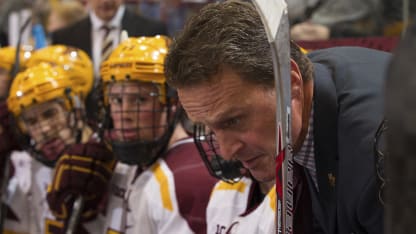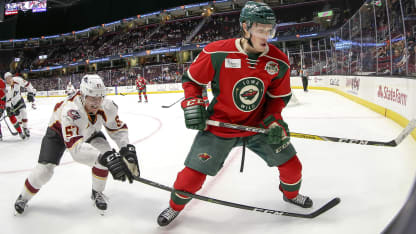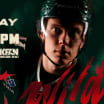ST. PAUL -- It's a Wednesday afternoon at TRIA Rink at Treasure Island Center, the Wild's shiny new practice facility in downtown St. Paul.
In a couple of hours, the Wild will hop on a plane and travel to Denver, Colorado to open its regular season.
As players shuffle back to the dressing room, defenseman Nick Seeler and forward Matt Hendricks are two of the final people on the ice. Hendricks has Seeler tied up, ready to throw a punch.
Sweet emotion: Seeler on his way to becoming staple in Wild's lineup
Rookie defenseman brings physicality and attitude in first full season with Minnesota

By
Dan Myers
Wild.com
In his head, Seeler is taking notes. The 37-year-old veteran is giving the 25-year-old rookie some pointers should he ever get stuck in a similar position.
Seeler has nearly two dozen games of NHL experience and two fights under his belt, including one in a preseason game just a few days earlier. He earned a black eye in that fight. Determined not to let it happen again, Seeler enlisted the advice of the oldest player on the team.
"Always trying to learn something," Seeler quips as he heads back to his locker.
Emotion has been at the heart of Seeler's game for as long as the Eden Prairie native can remember picking up a stick for the first time.
It's what helped make him a professional hockey player. It's what got him to the National Hockey League. And it's what keeps him there now, technically still a rookie, but with 24 games of experience under his belt.
"I was definitely high-strung, and just competitive," Seeler said. "But I think I've learned over the years how to channel that into something good."
After winning two state championships at Eden Prairie High School, Seeler played one year in the United States Hockey League then began his collegiate career at the University of Nebraska-Omaha.

© Getty
Following his sophomore season, Seeler -- then 21 years old -- chose to transfer back home to the University of Minnesota. A fifth-round draft pick of the Wild three years prior, it meant sitting out a crucial development year because of NCAA bylaws.
But as it turned out, that year "off" turned out to be one of the best things to happen to him.
Unable to play in games, Seeler practiced every day with the Gophers, using those practice sessions as his game situations. He matured both on and off the ice, thanks in part to the guidance of former Minnesota associate coach Mike Guentzel.
"He treated me as if I was playing, he really did," Seeler said. "The only thing I really didn't have were those game experiences. But he's a great coach, and he knows a ton about the game and defensive situations. He worked with me the whole year and I got to watch games and learn from the guys playing.
"I grew as a player and more importantly, as a person."
A lot of that growth came from within.
Guentzel immediately recognized the kind of player Seeler was, but knew the year away from games would present him with a big challenge. On weekends during which the Gophers were on the road, Seeler would be away from his coaches and teammates for three or four days at a time. That meant he would have to get better on his own, both on the ice and in the weight room.
"There was a lot in that year of sitting that he had to overcome," Guentzel said. "One thing I respect and appreciate about Nick is he came to realize what he was as a player. He realized, 'OK, this is what I have to be, I've gotta be simple, I've gotta be smart, I've gotta be positionally sound,' and I think those are the things he really worked on."
Seeler returned to game action in 2015-16, his only season with the Gophers, before turning pro. He didn't score a goal, but he led the team in blocked shots and was a physical force.
Sometimes, a little too physical.

© Minnesota Athletics
"He crossed the line a few times with some penalties and some five-minute majors," Guentzel said. "He crossed the line a little bit and ultimately, that cost us a little bit."
Former Gophers head coach Don Lucia took a hard-line approach to Seeler's antics and established that those kinds of things would no longer be allowed.
Seeler adapted and toned things down.
"When he wasn't practicing for three or four days at a time, it was hard to come out on Monday and have your edge right away," Guentzel said. "He had to adjust to a lot of things that other guys didn't have to, and a lot of that took his emotional stability to just say, 'Calm down, get to the next play and move on,' and that's really where he grew as a player."
While Seeler had learned to control that emotion, it still played a central part in his game when he arrived in Iowa in the fall of 2016, ready to begin his professional career.
And while his emotions got the best of him at times at the collegiate level, Iowa associate coach David Cunniff loved it, but was determined to help him manage it and control it.
"I'd rather tame a lion than poke a mouse," Cunniff said. "I've had plenty of mice in my day, and no matter how you poke them, they don't really get that fire. Nick was definitely a lion that you were trying to tame a little bit."

© Getty
That first year in Iowa was tough. There were some who doubted whether Seeler had the game to excel at the AHL level, much less the NHL.
With every mistake came emotion, which sometimes led to another mistake.
"He'd feel like he let the team down, because that's just his character," Cunniff said. "I think he thought, 'If I make one mistake, I'm gonna be out of the lineup.' And that was the case sometimes. [He] almost had to play perfect hockey."
Cunniff has always been one to allow his defensemen a chance to atone for mistakes. And as Seeler gained experience, he was scratched less and less. Eventually, the game slowed down and he got more ice time.
By the end of his first season in Iowa, Seeler was a regular in Iowa's lineup and put himself on the NHL radar.
"He really believed in me and helped me grow as a player," Seeler said. "You learn a lot fast, and you have to. If you want to continue to grow and get better as a player, you have to learn quickly. It was an eye-opener being in and out of the lineup. But with anything, you grow as you mature and get games under your belt, and I think throughout that first year in Iowa, I was able to pick out that the simpler [my game was], the better."
Seeler embarked on his first offseason as a pro determined to pick up where he left off at the end of the year. When he returned to Iowa at the start of the 2017-18 season, Cunniff was astonished: Seeler hadn't lost any of the progress from the season before or fallen into any of the two-decade old habits that often befall players at that level.
He was also getting more comfortable in tighter areas and becoming a more effective passer. Skating has always been a strength of Seeler's game, but he would sometimes panic and be too eager to get rid of the puck early during his time in Iowa.
As he gained experience, though, he learned the league and how to use his eyes to gauge how much time and space he really had.
Once Seeler did that, it all started to come together for him.
Cunniff said he teaches his defensemen about three different kinds of pressure they will face from an opponent. Heavy pressure means a guy is going to have to take a hit. Then there's medium pressure and no pressure.
"You're going back for pucks and you've got these big friggin' gorillas trying to run you through the boards," Cunniff said. "But if you're not using your eyes, medium pressure and no pressure feels like heavy pressure."
So Cunniff and Seeler spent hours working on using his vision. Cunniff would rim pucks around the boards, and Seeler would aim to keep his head up, locate "opponents," gauge the speed of pucks and figure out where it was heading.
"I would always talk about Bobby Orr, going back as he looks over his shoulder," Cunniff said. "The forecheck doesn't come as hard because they know they can't surprise you, so they end up slowing down. Where if you're staring at the puck the whole time, they come hard at you and they surprise you."
Seeler played in 49 games his second season in Iowa before getting the call of a lifetime to join his hometown team in the NHL, making his debut on Feb. 13 at home against the New York Rangers.
First expected to be a temporary injury replacement, Seeler was so good and provided such a needed physical presence in the lineup that he couldn't be sent back to Iowa.
Seeler had arrived in the NHL.
"He brought an element that we didn't have," said Wild assistant coach Bob Woods.
It didn't take Seeler long to make an impression with his new teammates. Just 11 games into his NHL career, he got into a memorable fight with Detroit Red Wings enforcer Luke Witkowski.
Witkowski had narrowly missed Wild forward Zach Parise with a big hit. If Parise hadn't moved at the last possible instant, it would have been a massive collision.

© Getty
Seeler didn't take kindly to Witkowski going after one of the Wild's star players, so he stepped up. Each player threw big hammers for several seconds, connecting on several.
"That was old school. And I had a front-row seat for it," Parise said after the game. "The sounds that were coming out of that thing ... it was nasty. It was a great scrap. I think I owe him a steak dinner after that. Standing up for teammates, you always appreciate that."
Minnesota scored its first goal 41 seconds after the fight, then scored again less than three minutes later en route to a 4-1 victory.
"He didn't show any timidness after coming up," said Wild goaltender Alex Stalock, who spent the entire season with Seeler in Iowa two years ago. "I remember when he came up last year thinking our guys didn't really know him. But I knew he'd be a big help. It might not be the prettiest thing you'll ever see right away, but he'd make a difference. And I think it translated ... look at our record over the last however many games he was up."
Stalock knows better than anyone the kind of value Seeler brings to the ice. As a goaltender -- and a smaller one at that -- being able to see the puck is critically important. Perhaps Seeler's best skill is a willingness to create room in front for his goaltenders by clearing opponents away from the crease.
"Once he's grounded in front, it's hard for people to move him," Stalock said. "You watch him, and he's engaging all the time. He's a physical player and he's learned early that engaging early and beginning that process of boxing out early is beneficial to his game and allows us to see pucks."
After endearing himself to teammates and coaches with his toughness, Seeler also worked to improve his relationships with officials.
As someone who plays with emotion and is most effective when pushing limits, knowing exactly where those limits lie is crucial.
"I spent a lot of time talking to him, telling him to work with refs, talking to them and always asking them, 'Let me know if I'm getting carried away,'" Woods said. "Where maybe before, he was a little emotional, he'd be barking at refs, and you can't do that here. You're a young guy, and they're going to run you."
Being as affable and personable as Seeler is certainly helps. One of the nicest guys in the Wild dressing room, Seeler's work ethic and willingness to do anything to win makes him a favorite of teammates as well.
"My work ethic is something that has gotten me here," Seeler said. "And it's something that hopefully is going to keep me here."


















